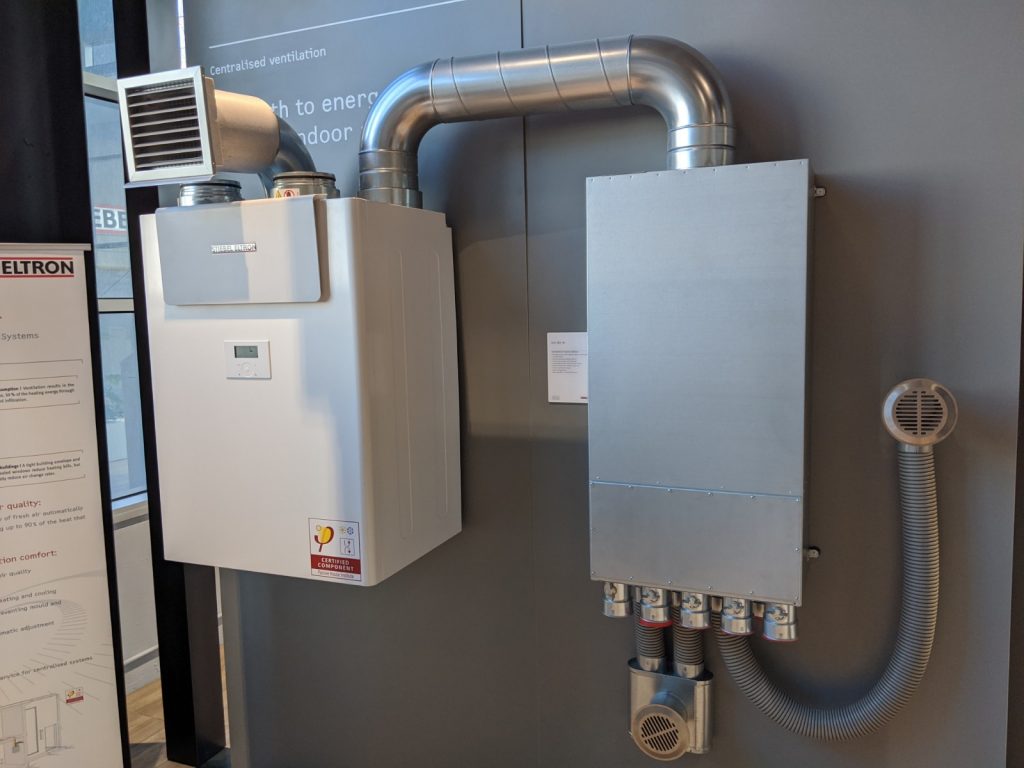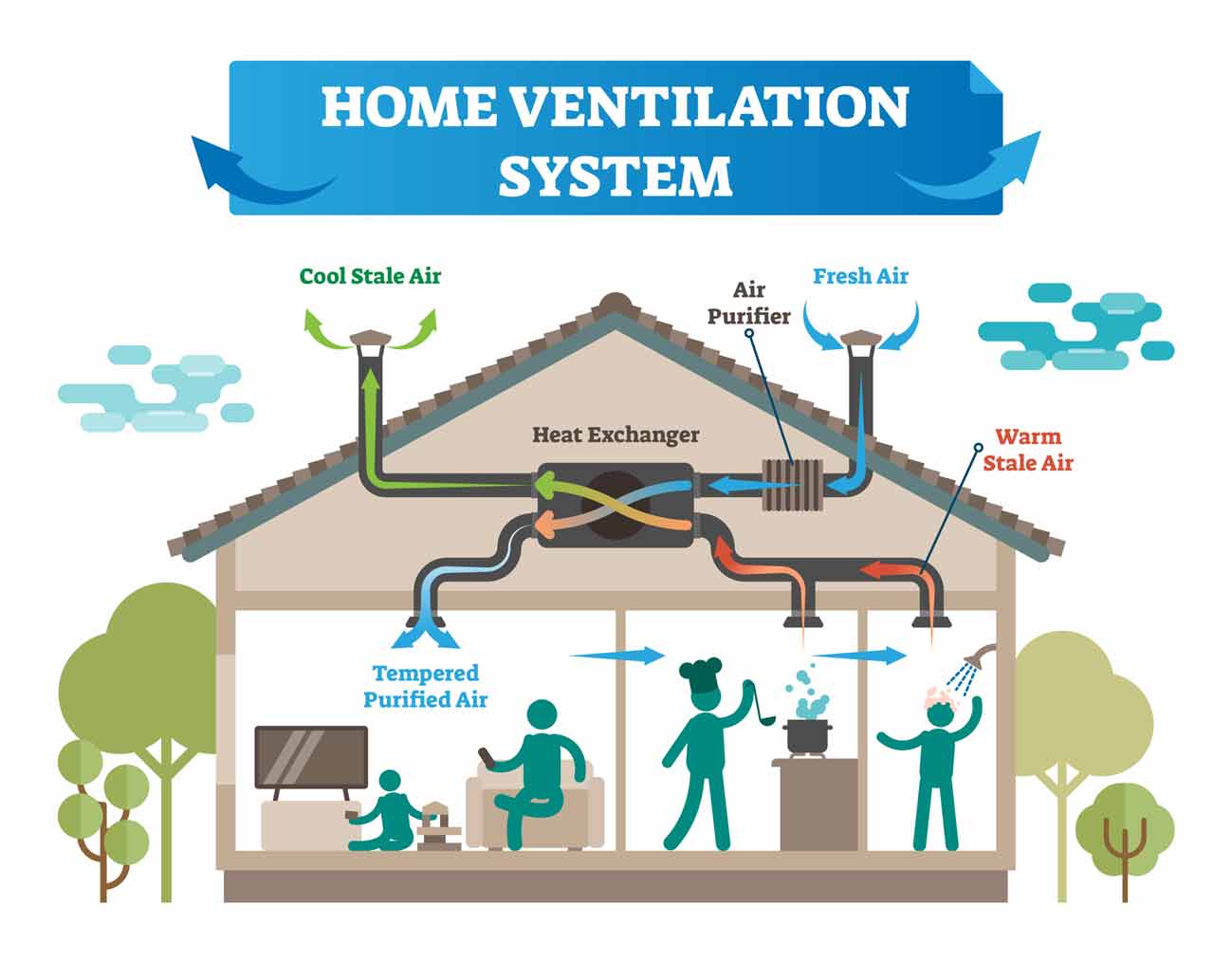Why HRV Is a Wise Investment for Modern Homeowners
Wiki Article
Revealing the Trick Advantages and Uses of Heat Recovery Ventilation in Sustainable Layout
Heat Recovery Ventilation (HRV) systems play a necessary role in lasting design. They promote a continuous exchange of stagnant indoor air with fresh exterior air, considerably improving indoor air top quality. HRVs contribute to power efficiency by reclaiming warmth from worn down air, which can decrease utility expenses. Understanding the complex benefits and applications of HRVs reveals their importance in contemporary design. What other benefits do these systems offer in the quest of sustainability?Recognizing Heat Recovery Ventilation Solutions
Heat recovery ventilation (HRV) systems are designed to improve interior air quality while decreasing energy loss. These systems make use of a mechanical air flow method to exchange stale interior air with fresh outside air, guaranteeing a continual supply of tidy air. By recording heat from the exhaust air, HRVs precondition inbound air, minimizing the need on heating and cooling systems. This procedure not only enhances thermal convenience yet also adds to power efficiency in household and business structures. Additionally, HRV systems assist regulate humidity levels and lower indoor contaminants, promoting a much healthier living setting. Their strategic application is important for achieving lasting layout objectives, as they supply a balance between energy conservation and owner wellness.Exactly How HRV Solution Job
While several might be acquainted with ventilation systems, understanding exactly how warmth recovery air flow (HRV) systems run is crucial for valuing their benefits. HRV systems function by trading stale indoor air with fresh exterior air while moving warm in between both streams. This process takes place in a heat exchanger, where warm from the outgoing air warms up the incoming air throughout chillier months, lessening energy loss. On the other hand, in warmer months, the system can cool inbound air utilizing the cooler outbound air. HRVs are furnished with followers to facilitate air movement and filters to eliminate particulates, making certain a constant, balanced ventilation procedure. This ingenious style not only boosts power performance however also adds to keeping a comfortable interior atmosphere.Enhancing Indoor Air Quality
Interior air high quality can greatly influence health and health, making efficient ventilation important in modern homes. Heat Recovery Ventilation (HRV) systems play a vital function in keeping interior air top quality by continuously exchanging stagnant indoor air with fresh exterior air. This procedure not only lowers airborne toxins but additionally minimizes moisture levels, which can bring about mold development and respiratory concerns. HRV systems filter incoming air, getting rid of allergens and particulates, therefore offering a much healthier living environment. Furthermore, these systems help get rid of odors and unstable natural compounds (VOCs) generally found in house products. By making certain a consistent circulation of tidy air, HRV systems add to a total enhanced interior atmosphere, advertising convenience and well-being for passengers.Power Efficiency and Cost Financial Savings
Energy efficiency attracts attention as a considerable benefit of Heat Recovery Ventilation (HRV) systems. By recording and recycling the warm from worn down interior air, HRVs decrease the power required for home heating incoming fresh air, leading to lowered energy consumption. This efficiency translates into lower utility costs, supplying significant price financial savings for property owners and services alike. Furthermore, HRV systems often get approved for power efficiency incentives and discounts, even more improving their financial appeal. Gradually, the preliminary investment in HRV modern technology can result in a favorable roi through reduced energy costs. The combination of HRV systems not only promotes sustainable design yet also provides a sensible remedy for achieving long-term power financial savings and financial benefits.Environmental Benefits of HRV

A wide variety of environmental benefits occurs from the implementation of Heat Recovery Ventilation (HRV) systems. By efficiently transferring heat from exhaust air to inbound fresh air, HRVs substantially lower the power required for heating and cooling down areas. This energy efficiency converts to decrease greenhouse gas discharges, contributing to a decrease in the total carbon impact of structures. In addition, HRV systems enhance indoor air top quality by continually distributing fresh air, thereby reducing the concentration of indoor pollutants and irritants. The reduction in power usage help in conserving all-natural sources, making HRVs a crucial element of lasting design. On the whole, the environmental advantages of HRVs play an important duty in promoting a healthier earth and promoting eco-friendly building techniques.
Versatile Applications in Modern Design
Heat recovery ventilation (HRV) systems are significantly being incorporated right into both domestic and business architectural tasks. In property settings, HRVs enhance indoor air high quality while maximizing energy efficiency. In business rooms, these systems optimize ventilation approaches, showing their versatility in contemporary building applications.Residential Projects Assimilation
While modern architecture progressively highlights sustainability, the combination of warmth recovery air flow systems in residential jobs has become a functional remedy for boosting indoor air quality and energy efficiency. These systems efficiently transfer heat from exhaust air to incoming fresh air, minimizing energy loss and lowering home heating or cooling needs. In brand-new builds and retrofits alike, heat recovery air flow can be seamlessly included, supplying property owners with a much healthier living setting while decreasing energy prices. In addition, with raising awareness of ecological influences, even more designers and building contractors are acknowledging the long-term advantages of these systems. Consequently, warmth healing ventilation has become a crucial part of lasting property style, showcasing flexibility and commitment to environmentally friendly practices.Business Areas Optimization
As contemporary business areas develop to meet the needs of sustainability and effectiveness, the implementation of warmth healing ventilation systems becomes a key approach for enhancing indoor atmospheres. These systems facilitate the exchange of stagnant indoor air with fresh outdoor air while recovering heat, considerably lowering power usage. This not just improves convenience for occupants but additionally assists in lowering operational prices. Flexible applications can be observed in workplaces, retail areas, and schools, where air high quality and temperature level control are critical. In addition, integrating heat recovery air flow straightens with eco-friendly structure accreditations, even more advertising ecological obligation. Eventually, embracing such systems in business architecture not just adds to sustainability objectives yet also promotes much healthier, more efficient areas for customers.
Integrating HRV Into Sustainable Design Practices
Integrating warmth recuperation air flow (HRV) systems right into sustainable style methods provides considerable advantages in power performance and interior air high quality. By using HRV, designers can produce affordable services that not only reduce power consumption yet likewise boost the general comfort of indoor environments. This positioning with sustainability goals positions HRV as an important element in contemporary architectural strategies.
Power Performance Improvement
By integrating warmth recovery air flow (HRV) systems right into sustainable design techniques, designers and home builders can significantly enhance power performance in contemporary constructions. HRV systems operate by catching heat from outbound stale air and moving it to inbound fresh air, reducing the power needed for heating or cooling down indoor areas. This process not just minimizes reliance on typical a/c systems however additionally reduces overall power consumption. In enhancement, HRV systems can assist maintain a consistent interior temperature, minimizing peak energy needs. By incorporating these systems, structures can accomplish significant decreases in energy expenses and carbon impacts, lining up with sustainability goals. Eventually, HRV technology stands for a sensible service for improving power effectiveness in the built atmosphere, advertising more accountable resource use.Indoor Air High Quality Improvement
Just how can heat recuperation air flow (HRV) systems add to premium indoor air high see this page quality in modern-day buildings? HRV systems effectively exchange stagnant indoor air with fresh exterior air while recovering heat, lessening temperature level fluctuations. This process minimizes the focus of indoor pollutants, such as unstable natural substances (VOCs), irritants, and moisture, which can weaken air high quality and influence resident health. By preserving excellent humidity levels and guaranteeing a constant supply of tidy air, HRVs aid develop a much healthier interior setting. On top of that, these systems can be integrated click reference into sustainable design methods, promoting energy effectiveness alongside enhanced air top quality. HRV Heat Recovery Ventilation. As a result, HRV innovation plays an important role in advancing overall occupant comfort and well-being in contemporary building stylesAffordable Layout Solutions

Often Asked Concerns
What Upkeep Is Required for Heat Recovery Ventilation Solutions?

Upkeep for warm recovery air flow systems typically entails regular filter replacements, cleansing of warmth exchangers, assessment of fans and ducts, and making sure proper drainage. These tasks aid preserve efficiency and extend the system's life-span in time.
Can HRV Equipments Be Installed in Existing Structures?
Heat recovery ventilation systems can indeed be set up in existing structures. HRV Heat Recovery Ventilation. Retrofitting calls for careful planning and analysis of the building's design, making certain compatibility with current systems while making the most of power efficiency and interior air qualityHow Do HRV Equipment Impact Noise Degrees Inside?
HRV systems can affect interior noise levels by presenting audio from external sources with air flow. Nonetheless, premium installments often integrate sound-dampening functions, decreasing noise impact while supplying effective air exchange and keeping convenience inside your home.Exist Any Type Of Disadvantages to Using HRV Systems?
The downsides of making use of HRV systems consist of possible high preliminary expenses, maintenance challenges, and the possibility of decreased interior air high quality if filters are sporadically transformed, which can bring about problems with humidity levels.Just how Do I Select the Right HRV System for My Needs?
Choosing the right warm recuperation ventilation system entails reviewing certain requirements, such as building size, climate, and energy effectiveness goals. Furthermore, assessing system attributes, setup needs, and upkeep considerations is essential for peak efficiency and fulfillment.Report this wiki page